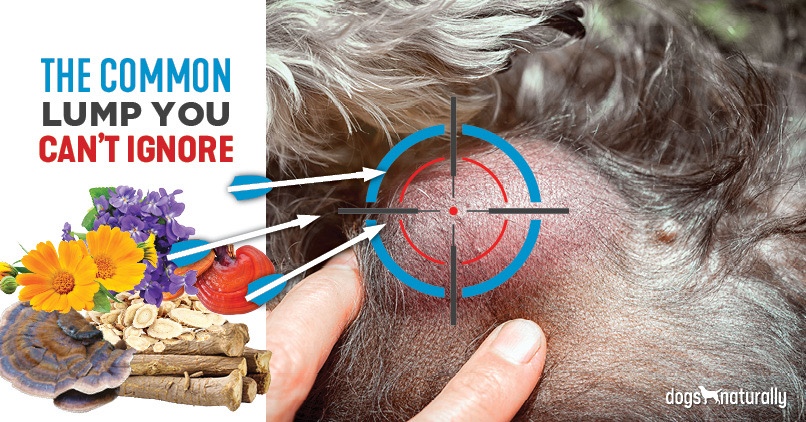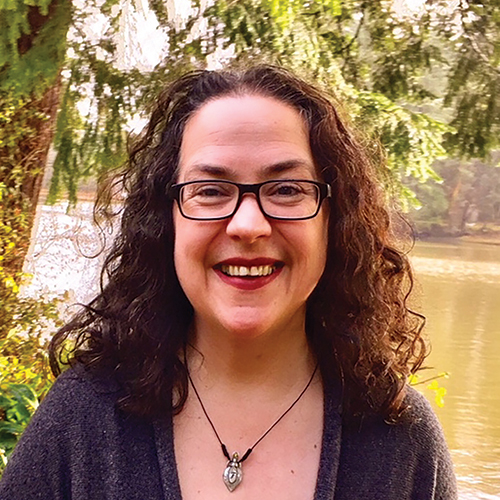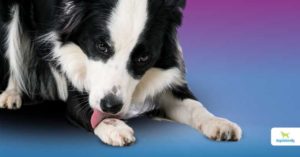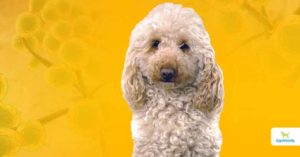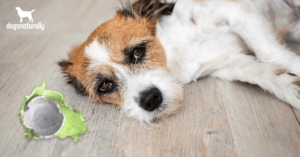I’m always leery of feeling around my pug’s skin in case I come across a lump.
Pugs, boxers, bulldogs, Boston terriers – all my favorite breeds – are prone to lumps and bumps.
Especially the dreaded mast cell tumor …
What was once a highly uncommon lesion is now a frequent conventional disease.
Unfortunately, the squished-nosed dogs of the world are not the only ones who get mast cell tumors. They’ve become a common diagnosis and an inevitable fear for most dog owners.
What Are Mast Cell Tumors?
The body produces mast cells as an inflammatory and histamine response. This is a part of normal immune function.
Mast cell tumors (MCTs) happen mostly on the skin but sometimes in the internal organs.
Mast cells are part of your dog’s immune defense system. They live within the tissues that contact the outside world. This includes the skin, respiratory tract and intestinal tract.
The mast cell’s main job is to defend against parasites.
They have unique granules within their cells that act like small bombs. The cells release those granules into the tissues to destroy the “invader.” This release also signals other body defenses to assist as needed.
Our dogs are living in a much cleaner world than their ancestors. They don’t run into parasites as often as they once used to.
So the mast cells are looking for a job.
This means they sometimes react to other environmental triggers that have a similar shape or size to parasitic antigens … like pollens and proteins. This is when you might see signs that look like allergies … local skin redness, itching, swelling, sneezing or watery eyes.
As I mentioned, MCTs stem from the body’s inflammatory and histamine responses. MCTs have an affinity for the blood, digestive system, skin, spleen and liver.
Dogs who might be prone to MCTs are dogs who often suffer from:
- Food sensitivities
- Allergies – food and environmental
- Chronic inflammation – stemming from problems like skin complaints, ear infections, arthritis, poor diets or autoimmune issues
- Leaky gut or dysbiosis – inflammation of the intestinal lining that allows food particles, bacteria and toxins to get into the blood stream
RELATED: Does your dog have leaky gut?
Showing up as a raised, somewhat pink lesion, MCTs can swell and change size over time. They can expand and shrink as the cancer releases chemical signals like histamine.
Many dogs who suffer from seasonal allergies deal with the release of histamine. This reaction happens continually when a dog has an MCT.
Not all mast cell tumors are malignant. They can appear in many places on the skin without systemic disease.
Let’s talk about the difference between malignant and benign MCTs
Benign vs Malignant MCTs
Benign means that the group of over-reactive mast cells is in a localized area of the skin or an organ … and it’s not spreading to other areas.
Malignant means that the group of over-reactive cells is in the original area … but it’s also spreading to other parts of the body. This could mean more skin lesions or invasion into other body organs.
When your vet tests the cells within the lump or lesion, she’ll
First, let’s look at the symptoms of MCTs.
Symptoms Of Mast Cell Tumor Disease
The most common symptom of an MCT is a solid to semi-solid lump on the skin. However, the symptoms can vary, and include:
- Acid indigestion
- Appetite fluctuation
- Blood pressure changes
- Bloody stool
- Dry skin
- Fatigue
- Itching
- Swelling
- Vomiting
Diagnosing MCTs
If you suspect a mast cell tumor, take your dog to the vet for diagnosis so that you can decide on the best treatment option. Thankfully, the prognosis for most MCTs is good. This is because a high number of lesions are superficial.
Needle aspiration, with blood work and urinalysis, is the most common type of testing.
Many people choose surgical removal of the tumor(s). This brings down the tumor load and then you can support the body holistically.
A detailed diagnosis is important because there are many treatment options. Your choice will depend on whether you prefer a conventional or more holistic approach.
Thanks to advancements in science, your vet can now test tumor cells to find out 2 important things: the “grade” and the “stage” of the tumor.
Grading defines the type of mass and the characteristics of the abnormal cells. When a mass is removed, staging then measures the extent of the tumor. It tells you whether all abnormal cells were removed, and whether – or how fast – the cancerous mast cells may spread in the body.
So getting MCTs graded and staged can focus your efforts … and help you decide on treatment options.
MCT Grades
MCTs are graded from I to III.
Grade I tumors are usually confined to the dermal layer. The cancer cells are “well-differentiated”. This means they look like normal healthy tissue.
Grade I cells are almost always slow-growing … they stay within the area of growth. They’re usually non-malignant (benign) but you and your vet should keep an eye on them.
Grade II tumors can still be on the skin … but involve deeper tissue and lymph nodes. They are often classified as stage II (read more about stages below).
The cells don’t look like healthy tissue … and they spill out of their once confined margins (the margin is the area around the tumor, where cancer cells are bordered by healthy cells).
Grade II MCTs can start off as non-malignant but change as the cells move out of their original margins.
Grade III tumors are migratory and they are malignant. They take over healthy tissues faster. Sometimes lymph or organs are involved.
Most grade III tumors are defined as stage III. This means there are multiple tumors … or one large tumor with lymph node involvement. They can spread quickly so fast treatment is a must!
MCT Stages
There are five levels of stages and these are the definitions:
Stage 0: One tumor in the skin incompletely removed, with no lymph node involvement.
Stage I: One tumor in the skin, with no lymph node involvement.
Stage II: One tumor in the skin with lymph node involvement.
Stage III: Multiple large, deep skin tumors, with or without lymph node involvement.
Stage IV: One or more tumors with metastasis in the skin with lymph node involvement. This stage is divided further into tumors with no other signs (substage a) and tumors with other clinical symptoms (substage b).
So again, knowing the stage is important. Stage IV mast cell tumors mean there’s metastasis in the skin. There may also be organs with or without high blood counts.
You can read more about grades and stages at the National Canine Cancer Foundation.
Treatment Of Mast Cell Tumors
Most MCT cancers respond well to systemic treatment. Removal of superficial tumors can help bring down cancer cell loads, buying time.
I’ve also seen MCTs respond well to topical combined with internal treatment … without surgery. This choice is up to you and your holistic veterinarian.
The goal of surgery is to create clear margins, removing the tumor along with some healthy tissue. This helps to contain and remove the cancer.
MCTs cause excess circulating histamine. Allopathic medicine’s go-to drug for this is diphenhydramine (also known as Benadryl). It helps control the body’s histamine response.
Holistic health for dogs treats the body as an ecosystem. Some call this wholism. The key to stopping MCT progression and healing tumors is to deal with the disease at a root level:
- Calm the inflammation response
- Nourish and feed the immune system
- Help the body push through stagnation by supporting circulation and the nervous system
The immune and nervous systems all work together as part of the stress response. Stress is a silent killer that we often overlook in our furry companions. Our stress is their stress. Make sure you think about this when treating acute and chronic disease.
Dogs also experience stressors you may not think about, like:
- Being alone all day while you’re at work
- Dogs who travel and compete
- Living in a highly toxic environment
- Living in a city with high pollution
- Living near a farm that use toxic chemicals
Stress and nervous tension can also bind energy in the body. This can cause stagnant circulation and blood flow.
There are many MCT cases where a high-stress event is the initial cause. I’ve seen cases of tumors disappearing … then reappearing after major stress events.
The immune system is the seat of your dog’s ecosystem. It needs good circulation to keep the body balanced and the skin healthy. Yes, the liver is a key factor here … but don’t overlook the nervous system.
RELATED: Mushrooms for dogs: cancer benefits
Herbal Management Of Mast Cell Tumors
Herbal treatment for MCT means stopping the tumor from metastasizing or growing.
You can use herbs to treat visible tumors, topically and systemically. And herbs can also support circulation and elimination function.
Topical treatment can be extremely effective in shrinking tumors and repairing tissue. Lesions can get nasty looking while they heal … but consistent topical therapy is a must.
Holistic herbalism looks at the root cause of why the body produces MCTs in the first place. Then we support the immune and nervous system while naturally bringing down the histamine response.
Let’s look at the different natural options available for your dog. Although not a definitive list, these herbs will help you get started:
1. Ashwagandha (Withania somnifera)
Ashwagandha has a strengthening effect on the body. This makes it ideal to help with stress and recovery from chronic disease. This is a good herb for older dogs with MCT.
Ashwagandha has neutral to warming energetics. It’s good for dogs who have both MCT and hypothyroidism.
Avoid giving it to dogs with hot energetics. Most of these dogs will have a warm head, paws, visible redness and intolerance to heat. They’ll seek out cool places around the home.
Dry Herb Dosage: 100 mg per 10 lbs of bodyweight given 2x daily with food
Tincture Dosage: 1/2 ml for every 15 lbs of bodyweight given 2x daily just before food
2. Astralagus Root (Astragalus membranaceus)
Astragalus root is warming and helps with stress. It can help prevent metastasis. It can support the immune system by flushing metabolic debris through the kidney.
Astragalus can help increase appetite. It’s well indicated in young and older dogs. It has an affinity for dogs with generalized weakness.
If you opt for chemo and radiation, astragalus can help with recovery.
Dry Herb Dosage: 50 mg for every 10 lbs of bodyweight given 2x daily with food
Tincture Dosage: 1/2 ml for every 20 lbs given 2x daily just before food
3. Burdock Root (Arctium lappa)
Burdock is a warm, bitter root. It helps the body digest fats and oils as well as tone the digestive tract through the liver.
The digestive, liver and elimination systems are crucial in processing metabolic wastes. They also feed and nourish the immune systems.
Burdock root is mainly associated with the liver in conventional herbalism. But it also supports elimination through the kidneys.
Burdock has a direct relationship to the skin, so it’s good for dermal MCT with dryness … and where fluids are building up.
Dry Herb Dosage: 50 mg for every 10 lbs of bodyweight given 2x daily with food
Tincture Dosage: 1/2 ml for every 20 lbs given 2x daily just before food
4. Calendula (Calendula officinalis) and Cleavers (Galium acarine)
Calendula and cleavers are foundational herbs in canine herbalism.
I’ve found one or the other will help with elimination and drainage of the lymphatic system. The lymphatic system lacks a pump and is stimulant and movement-fed. Good lymphatic drainage is critical in treating any cancer.
Choose calendula for dogs who are neutral to cool, lean, and consistently seeking warmth. Choose cleavers for dogs who are warm, robust, and heat-intolerant.
The dosages for these herbs are small stimulating doses.
Tincture Dosage: give just before food
- Small dogs 1-2 drops 2x daily
- Medium dogs 3-4 drops 2x daily
- Large dogs 5-6 drops 2x daily
- X-large dogs 7-8 drops 2x daily
5. Dandelion Root And Leaf (Taraxacum officinale)
Dandelion root is the opposite of burdock root … it’s more drying than moist and cooling.
The root has an affinity to the liver, while the leaf works with the kidneys. I like to use a tincture of the whole plant for MCT.
Dandelion relaxes the nervous system and moves stagnation through the elimination systems. It also helps clean mucus out of the bloodstream.
Use dandelion when your dog is warm to hot with slow circulation. Weak digestion with a low appetite is also a good fit for dandelion.
Dry Herb Dosage: 150 mg per 10 lbs 2x daily with food
Tincture Dosage: 1/2 ml for every 15 lbs of bodyweight just before feeding
6. Echinacea (Echinacea angustifolia, purpurea)
Echinacea is a stimulating cooling herb known for its immunity effects.
Echinacea brings down the allergy response, combating systemic inflammation.
I like to use a tincture of the entire plant for mast cell tumors. The flowering tops and roots help with excess histamine levels from the tumors.
Echinacea is a good addition to a mast cell protocol where there’s blood and lymph involvement. It helps clear fluids and increase white blood cell counts.
Even though most herbal protocols suggest Echinacea angustifolia, I think the purpurea is more affective with MCT. But you can use either interchangeably.
Dry Herb Dosage: 150 mg per 10 lbs 2x daily with food
Tincture Dosage: 1/2 ml for every 15 lbs of bodyweight just before feeding
7. Maritime Pine Bark (Pinus pinaster, maritime)
Maritime pine bark is high in antioxidants and helps strengthen the immune system.
Consistent use helps push through systemic stagnation and increase circulation. These are two of the pillars of MCT treatment. It’s also a powerful natural antihistamine. Avoid during chemotherapy or radiation treatments.
Dry Herb Dosage: 25 mg for every 30 lbs of bodyweight, away from food.
Tincture: 1/2 ml per 20 lbs of bodyweight, away from food.
8. Nettles (Urtica dioica)
Nettles fortify and strengthen the body helping decrease systemic histamine levels.
Nettles work with the digestive, immune and liver systems. They also support elimination through the kidneys.
For MCT, I like to combine nettles with quercetin and bromelain. This helps the body deal with histamine release.
Some dogs are sensitive to bromelain. It may cause dermal itching, nausea, and vomiting. If this happens, stop the bromelain … and use just nettles and quercetin.
Dry Herb Dosage: 100 mg per 10 lbs 2x daily with food
Tincture Dosage: 1/2 ml for every 15 lbs of bodyweight just before feeding
Quercetin Dosage: 100 mg for every 30 lbs of bodyweight 2x daily with food
Bromelain Dosage: 25 mg for every 15 lbs of bodyweight 2x daily with food
9. Red Clover (Trifolium pratense)
Red clover is cooling and brings moisture to the tissues.
Like burdock root, it’s a good choice when the skin is dry. It’s also good for MCT with lymph involvement. It’s specifically used when there are nodules – like MCTs. I recommend using red clover as part of a formula, not alone.
Dry Herb Dosage: 100 mg per 15 lbs 2x daily with food
Tincture Dosage: 1/2 ml for every 15 lbs of bodyweight just before feeding
10. Sweet Violet (Viola odorata)
Violets are one of my favorite cooling herbs for stagnation.
Violet is appropriate for most dogs with MCT. It helps support the nervous system, supports lymphatic drainage and relieves pain. Sweet violet works well for overweight, warm to hot dogs who pant easily.
Avoid in dogs who are cold, deficient and weak (for the purpose of MCT).
Tincture Dosage: 1/2 ml for every 10 lbs of bodyweight just before feeding
Traditional Chinese Medicine (TCM) Herbal Options
TCM has a few effective internal and external treatments for MCT. TCVM veterinarian Dr Josie Beug suggests using the powerful Xue Fu Zhu Yu Tang combination.
These herbs work on the same premise as western herbs … they support the movement of energy, fluid and circulation (stagnation).
Dr. Beug notes, “When stagnation occurs, mast cells can accumulate, and if the stagnation is not relieved, a tumor develops.”
Dr. Beug explains the formula is well indicated when:
- The tongue is purple
- The mass is “irregularly shaped”
- It’s solid with pain
- There’s possible bleeding
Dosage:
- Small dogs – 1/8 teaspoon 2x a day
- Medium dogs – ¼ teaspoon 2x a day
- Large dogs – ½ teaspoon 2x a day
- X-large dogs – 1 teaspoon 2x a day
E Zhu (turmeric) is a good addition to this formula. It brings down inflammation and stimulates circulation. It works well to resolve blood stagnation. Don’t use it for dogs who are too warm.
San Leng, the rhizome of Bur Reed, is another good one. This herb makes a good alternative to turmeric.
Dr Beug points out that San Leng is “one of the strongest herbs available for Blood Stasis (stagnation) and its anticancer activity has been reported in Western scientific journals”.
San Leng has an affinity for the liver and stomach meridians. This makes it productive for internal mast cell cancer.
As you can see, there’s crossover from western to Chinese herbalism. Remember, dogs are individuals. Both western and Chinese herbs can have varying effects on different dogs.
Do your best to match your herbal choices to your dog’s unique constitution. With all of the herb options available it’s best to consult with your holistic vet or canine herbalist to find the right match and dosing plan for your dog.
Medicinal Mushrooms
Mushrooms have been getting a lot of hype these days. And rightfully so, as many medicinal mushrooms can help strengthen the immune system.
Many mushrooms can help treat and prevent different types of cancer. Popular medicinal mushrooms include turkey tail, maitaike and shiitaki. Two mushrooms specifically addressing mast cell tumors are reishi and chaga.
Reishi (Ganoderma lucidum)
The reishi mushroom builds immunity and increases natural killer cells. This supports apoptosis (cell death). This can cause tumors to shrink.
Many mushrooms have an antihistamine effect on the body. Instead, reishi helps stabilize mast cells. This makes it a foundational ingredient in most MCT protocols.
Chaga (Inonotus obliquus)
Chaga mushrooms are an important active mast cell tumor remedy.
Chaga’s proven ability to stabilize systemic histamine responses is impressive. It’s also anti-inflammatory and immune-modulating.
Chaga targets cancer cells while leaving healthy cells alone. It induces cell death while bringing down inflammation. When treating superficial mast cell tumors, you can use chaga both externally and internally.
Keep reading for a chaga paste recipe you can use topically.
Turkey Tail (Trametes/Coriolus/Polyporus versicolor)
Turkey tail mushrooms are specific for tumor-based cancers. They boost the immune system and help target systemic tumors. They help keep tumors from getting larger and spreading.
Turkey tail works with the lymphatic system, increasing T-cell proliferation. It also has a high percentage of protein-bound polysaccharide content … that helps with immune function.
Studies have shown that turkey tail not only boosts immune function … it also modulates immune response. This keeps the immune system from harming itself while targeting tumors.
RELATED: Turkey tail mushroom uses for dogs …
Mast Cell Tumor Chaga Paste
Make a tea with one tablespoon chaga powder with 2 ounces of almost boiling water. Steep, covered, for 30-40 minutes.
To a blender, add:
- Chaga
- Chaga tea
- 1/4 oz castor oil
- 1/2 ounce neem oil into a bullet blender or use a stick blender.
Pulse-blend to make a paste. Add additional chaga powder to achieve paste consistency.
Apply to tumor, cover with gauze and leave overnight. Apply this daily. Mixture will last for 2-3 days in the refrigerator.
You can use vet wrap to keep gauze in place. You can also use chaga paste as a poultice 2-3 times daily.
Quality Note: Do your research when you buy mushrooms. Make sure they’re sourced organically and sustainably. That way, we can all benefit from these natural medicines for generations to come.
And make sure you buy real mushrooms, not mycelium. There’s an important difference.
Many mushroom products are just mycelium grown on grain or rice. Mycelium is the part of the mushroom the fungus grows from … (it’s like the root of a plant) … and it’s not the whole body. Mycelium grown on grain has more starch and lower medicinal benefits than whole mushrooms.
All tumors are scary but there are options.
Work with your holistic or homeopathic vet to find solutions for MCT. The most important thing to remember is to remain calm and don’t give your dog this entire list of herbs at one time.
The successful treatment for one dog will not necessarily cure another. Choose your supplements and herbs wisely and with intention.

